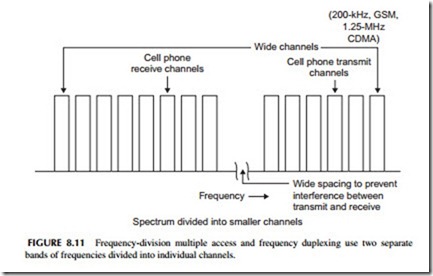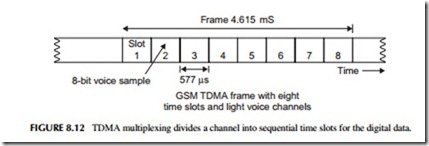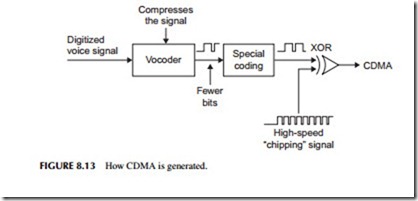ACCESS METHODS AND DUPLEXING
Access methods are wireless techniques that allow multiple users to share a given part of the frequency spectrum. Access methods are also called multiplexing. Multiplexing means allowing two or more signals to be transmitted concurrently over the same communications medium such as a cable or within a given frequency band. Access methods allow many subscribers to share precious spectrum space. And they provide the means to implement full-duplex simultaneous transmit/receive that most phone users expect. There are four types: frequency division multiple access (FDMA), time division multiple access (TDMA), code division multiple access (CDMA), and orthogonal frequency division multiplex access (OFDMA). For full-duplex operation, there are two methods— frequency-division duplexing (FDD) and time-division duplexing (TDD).
FDMA—A given bandwidth is divided into many narrower channels as shown in Figure 8.11 . A given radio will cover all of the bands but has the ability to select a specific operating frequency. GSM divides the band into 200-kHz channels. cdma2000 uses 1.25-MHz channels and WCDMA uses 5-MHz channels. The newer OFDM uses 5-, 10-, 15-, or 20-MHz channels. FDD—Simultaneous transmit and receive is accomplished by using two different bands where half are used for transmit and the other half for receive. The transmitter and receiver operate at the same time but on different frequencies so they do not interfere with one another (see Figure 8.11). TDMA—With this method, a single-frequency channel is used, but the signal is divided into fixed-duration time slots into which digitized segments of voice or data are transmitted. In digital voice transmission, the analog voice
signal is periodically sampled and digitized into a stream of binary numbers. These binary values are then compressed into a smaller number of bits by a vocoder circuit. The resulting bits are then transmitted to the receiver. With TDMA, binary values from two or more voice sources can be inter- leaved and sequenced, and then sent over the single channel. For example, in GSM systems, there are eight time slots, as shown in Figure 8.12 . The data is transmitted at a 270-kbps rate in a 200-kHz wide channel. Each time slot contains 1 byte of the voice data for one phone call. The frame of eight signals is then repeated.
TDD—Time-division duplexing facilitates concurrent send and receive by assigning transmitted signals in one time slot and received signals in another time slot. They share the same frequency channel. Because all this is happening at a high rate of speed, you cannot determine that transmit and receive are not simultaneous, although in reality they are not. CDMA—This method uses spread-spectrum technology. It takes the digitized voice and further processes it to give it special coding, and then spreads it over a wide bandwidth. In cdma2000 phones, the channel bandwidth is 1.25 MHz wide, and all cell phone signals are coded and spread over this bandwidth. The process goes like this: the analog voice signal produced by the micro- phone is digitized in an ADC, and then compressed by a special digital circuit called a vocoder or voice coder. This reduces the total number of bits and the speed of the digital signal. This vocoded signal is then mixed with a high-speed serial code signal, making it unique so that the receiver will recognize it. This is done with an XOR gate as shown in Figure 8.13. The higher- frequency signal, at 1.23 Mbps, is called the chipping data. The resulting signal fills the 1.25-MHz channel. In WCDMA systems, the process is the same, but the chipping signal is 3.84 Mbps and the channel width is 5 MHz.
Many cell phone calls are then transmitted on the same channel. They actually all mix together, but because they occur randomly with one another, they do not interfere with one another. Typically, up to about 64 users can share the same bandwidth. One signal simply appears as a low-level noise to another. The desired signal is picked up at the receiver by recognizing the unique code given to the transmitted signal. The two most common types of spread spectrum are direct
sequence and frequency hopping. Direct-sequence spread spectrum (DSSS) is used in cell phones as illustrated in Figure 8.13. Frequency hopping is used in Bluetooth wireless systems (see Chapter 9). Most duplexing is by FDD, but some of the newer versions of WCDMA also use TDD.
OFDMA
Access with OFDM is done by just assigning one or more of the subchannels to each phone call. With each subchannel 15 kHz wide, each is capable of carrying a compressed (vocoded) voice signal so that many calls can be handled. In practice, more than one channel may be used, depending on the specific frequency assignments, bandwidths, and other features of the LTE system being used.


